Punctuation is important when you teach English it helps to organize writing it’s also important for reading
Can you see why students should learn to punctuate correctly? Anchor charts are a perfect way to do this.
In this post, you’ll find some ideas of what to look out for in a punctuation anchor chart. I have also given you some ideas of how to use them in the classroom.
Table of Contents
- Elements of a good punctuation anchor chart
- Different ways to portray punctuation
- Resources from TeachSimple
- Resources from other teachers
- What Gets a Capital Letter?
- Free Punctuation Anchor Chart resources
- Final thoughts on punctuation anchor charts
Elements of a good punctuation anchor chart
A good punctuation anchor chart must make the punctuation mark/s stand out.
The uses of the mark should be clearly explained.
There should be specific examples that show how the punctuation marks are used in context.
Some punctuation anchor charts are comprehensive and present all the punctuation marks. Make sure that the students understand that some marks have more than one application.
Different ways to portray punctuation
Because there are so many punctuation marks and each is used in different ways, anchor charts are the perfect resource to demonstrate this. You can include rules and examples on the charts. The students can use these to work on examples to practice their punctuation.
Commas
Let’s assume you are teaching how commas are used to separate items in a list.
Put the rule at the top of the anchor chart: If there are more than two items in a list, use commas between them.
Follow this with an example.
With higher grades, this can be written (eg. There were seven dolphins, three swordfish, two tuna and one crayfish in the net.)
For lower grades, you can be creative and use pictures to indicate the items. This would mean arranging five items in a row on the chart (eg. apple, orange, nuts, banana, peach). Using a bright pen or crayon, draw commas between the first four items, then fill in ‘and’ between the last two items.
Repeat this with other rows of pictures on the chart. You can invite the students to come up to the chart and fill in the commas.
The anchor chart then becomes a resource in your classroom.
Apostrophes
You will need to make it clear to students that an apostrophe has two uses: contraction and possession.
This is a great opportunity to create an interactive anchor chart. Prepare an anchor chart to teach contraction. Below the heading, include some examples.
Then, you can create an interactive activity with the chart.
Adhesive letters
What will work well is if the letters are attached individually, possibly with adhesive putty. So, the first line would read: ARE NOT
Invite individual students to come to the chart and remove the letter that will be replaced. They should stick an apostrophe in its place. So, they create: ARE N’T
They should then move the two parts of the new word together.
Crossing out letters
You can teach the same point by dividing the chart into two columns. On the left, write the two words that will be combined (such as DO NOT). In the right-hand column, put the two words together, without an apostrophe (such as DONOT). The students must take out the correct letter and replace it with a apostrophe. This may be done with adhesive letters or by crossing out the relevant letter.
Resources from TeachSimple
These resources are not presented as anchor charts. However, there is a close relationship between worksheets and anchor charts, as you will see.
Apostrophe with Possessives Worksheet
‘Apostrophe Catastrophe’ is not an anchor chart, but a worksheet. However, the layout and content are a great idea for a chart. You could make one to go with the worksheet, so the exercise becomes more interactive.
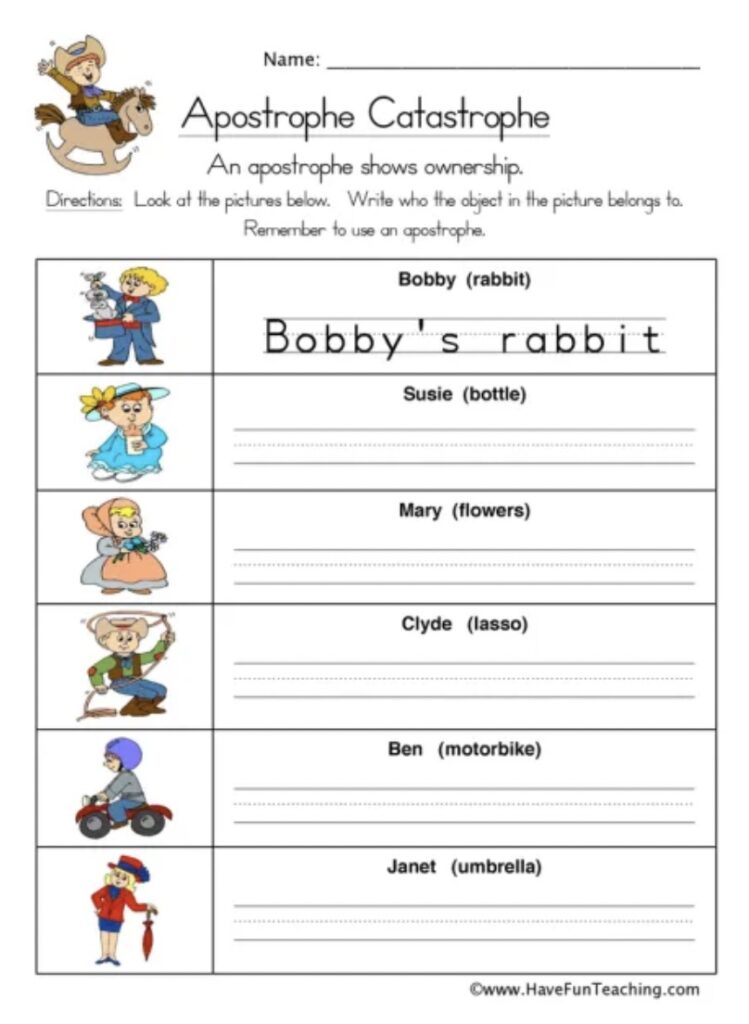
Comma with Quotes Worksheet
This resource is also a worksheet, on commas. It is also a good idea that you can adapt into an anchor chart. The focus here is on using a comma before direct speech or quotes. It would be easy to take the pattern of the worksheet and create an anchor chart that gives perhaps fewer examples, but the question and answer. This becomes a reference for the worksheet.
Have Contractions Worksheet
Here is another worksheet you can adapt into an anchor chart. This is on Contractions with have. As with other worksheets, you can devise an anchor chart that presents the point to the students. They can use this as a reference when they fill in the worksheet.
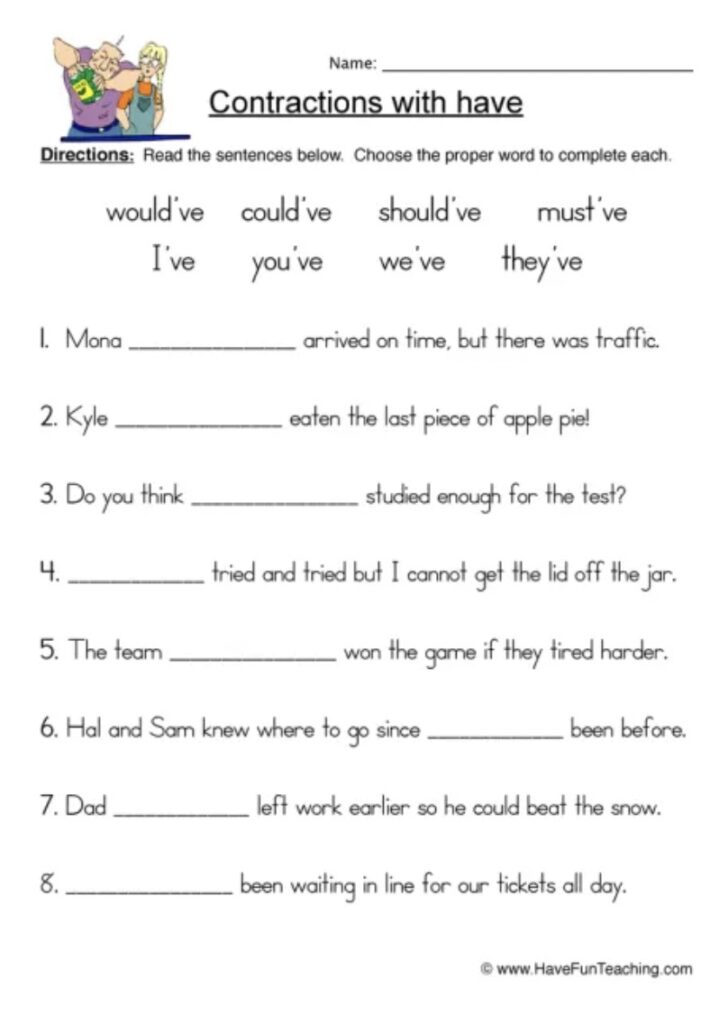
Another advantage of this resource is that you can use it as a template to teach all aspects of the apostrophe. Change the ‘have’ to ‘will / shall’, ‘would’ (etc) and you will have a series of anchor charts and worksheets on the use of the apostrophe.
Resources from other teachers
Personalizing punctuation marks
This resource is an anchor chart on punctuation marks in general. It is simple, but creative. Younger grades, particularly, will relate to the ‘characters’ that the marks have been given. The articulation of the function of the marks is perhaps a little sophisticated. This can be adapted, or taught, especially in context. I also think this would make a fun revision chart for older grades.
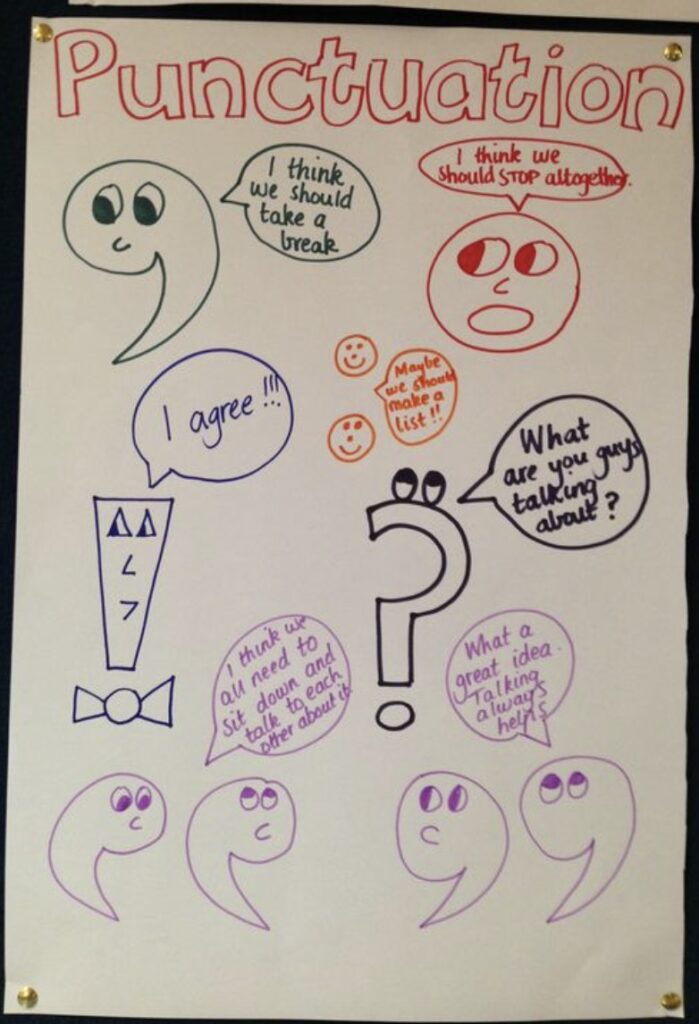
Putting it all together
This is a wonderfully comprehensive and interactive anchor chart on Punctuation Marks.
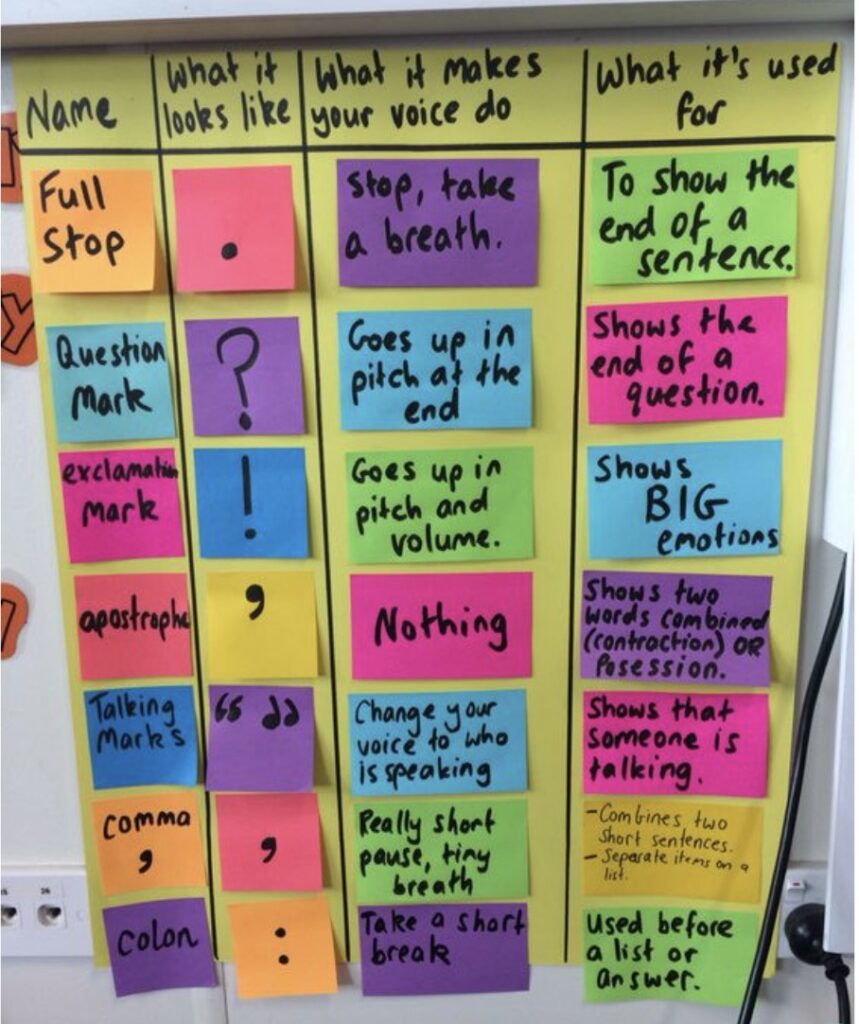
The chart features most of the main punctuation marks, which makes it immediately useful. Then, the columns give important information about each mark. Using post-its to populate the table is a great way for students to work on their knowledge of punctuation.
There are many ways of using the chart.
- Use this resource as a pop quiz.
- Color coordinates the different marks, to make it easier for lower grades.
- Mix up the columns and the students have to put everything in order.
What Gets a Capital Letter?
This is a chart that asks What gets a capital letter?
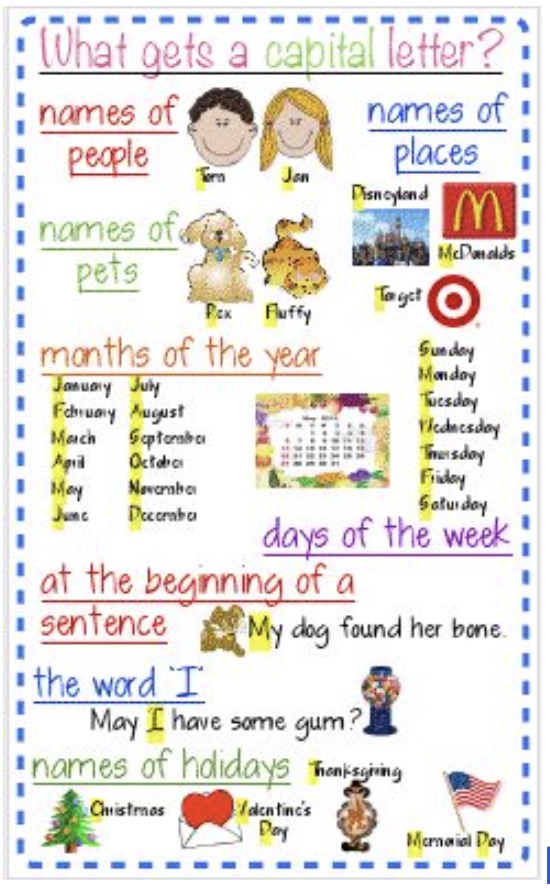
This is a really useful anchor chart that gives a very clear picture of when to use capital letters. You can use it as the inspiration for worksheets and practice exercises.
Colons and semi-colons
The focus of this resource is the colon vs semi-colon.
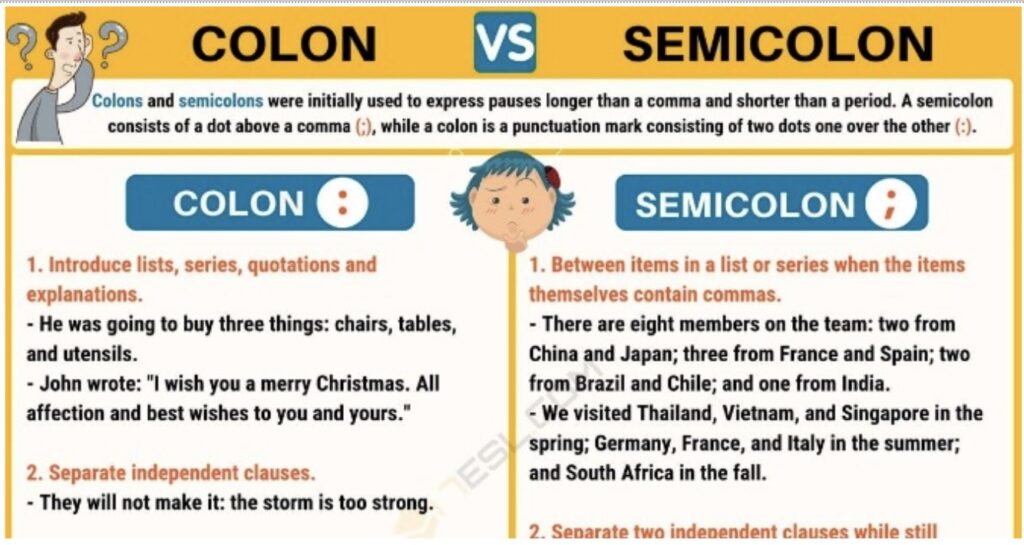
This is quite a formal anchor chart, which makes it look authoritative. There are good examples of each point, which give you a reference for students to work from.
Free Punctuation Anchor Chart resources
Come Down, Comma!
This resource is one that focuses on a particular aspect of punctuation: Commas
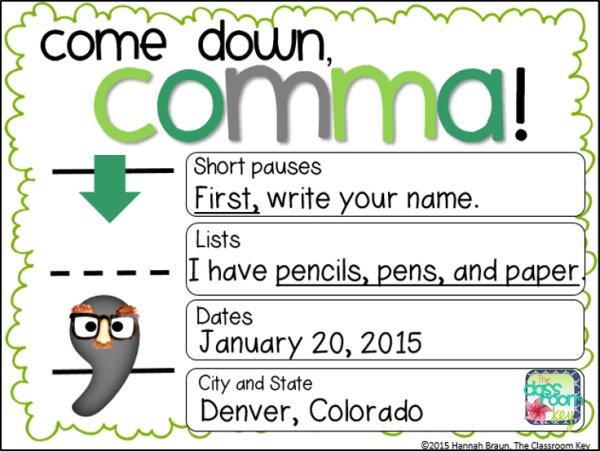
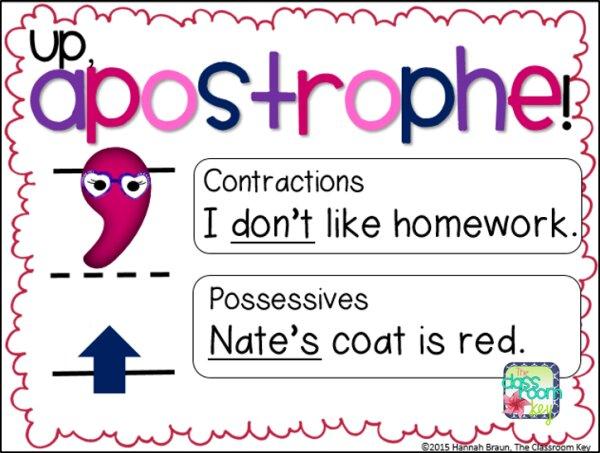
The appeal of this anchor chart is the way the comma is turned into a character. The examples are useful, but you will need to interpret them for the students. This is a great reference chart. You can use it as the inspiration for worksheets that allow students to practice using a comma correctly.
Punctuation and reading
This anchor chart brings punctuation and reading together.

I love this resource, because it is visual and uses some of the key punctuation marks in an innovative way. The dots representing a traffic light are stick on, which means you can make it an interactive resource. It is also a different approach to punctuation to include the way you use your voice when you see each punctuation mark in writing.
Final thoughts on punctuation anchor charts
There are a whole lot of different ways you can use anchor charts to teach punctuation. A comprehensive chart makes a good reference. To teach punctuation effectively, use individual charts that give information about each punctuation mark and examples that illustrate the points.

